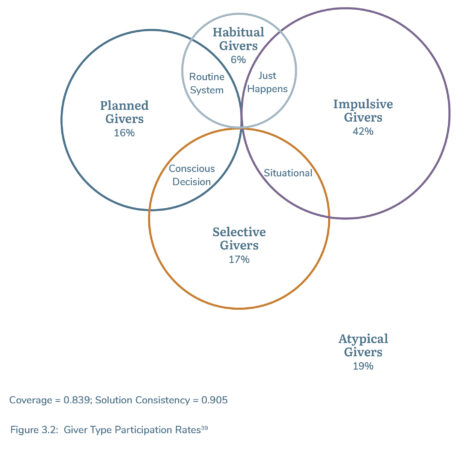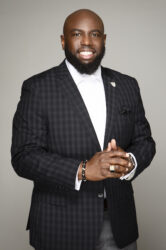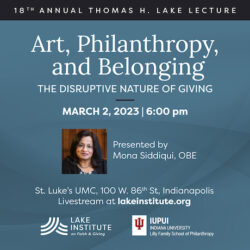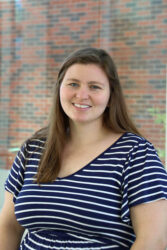Attending to Our Intention: The Need to Engage Regular, Religious Givers
Attending to Our Intention: The Need to Engage Regular, Religious Givers
by David P. King, PhD
With the ringing of the new year, many of us are resolved to adopt new habits, routines, and commitments. Perhaps the same is true for those of us committed to the work of religious giving and fundraising. As we move on from the frenzy of Giving Tuesday and year-end giving campaigns, what are the new rhythms, practices, or strategies to focus on defining our work in generosity in 2023?
Types of Givers
It turns out that our practices of giving, like most habits, are not easy to change. Most of us fall into a particular type of giver. While there is not necessarily a right or wrong way to give, it’s important for us to understand these giver types. As our colleague and Melvin Simon Chair in Philanthropy, Patricia Herzog identifies in her co-authored book, American Generosity, there are four main types of givers. The largest percentage of Americans (42%) are impulsive givers. Their giving “just happens” if or when they are presented with an opportunity. Seventeen percent are selective givers. They similarly exemplify a reactive approach to their giving even if they are more attentive to the various organizations or committed to a particular set of causes.

Herzog, P. and Price, H. (2016). American Generosity: Who Gives and Why. Oxford Univ. Press. p. 121.
In contrast, other types of givers follow more intentional strategies and giving practices. Sixteen percent of Americans are planned givers. These individuals have both a routine and conscious decision-making process in where and how they give. The smallest percentage of givers (6%) fall into the fourth type, habitual givers. While they may not dedicate as much thought as planned givers to every giving opportunity, it’s often because they have intentionally adopted routine giving practices that are a regular part of their lives. While smaller percentages of the population, it is also true that these last two types generally give more and more often.
There are religious individuals among all types, but givers with higher levels of religious engagement are more likely to fall into the latter two types: planned and habitual. Why? I think it is the shared focus on intention, routine, and regularity that aligns these approaches to giving with the motivations and practices of religious individuals. Whether it is the Christian practice of tithing a specific amount of one’s income, the focus of Muslim giving to pay zakat in the month of Ramadan, a Jewish obligation to give tzedakah to one’s local and international faith communities, or the daily giving (dana) of rice or coins to those in need in Hinduism or Buddhist traditions, our religious cultures promote giving as a regular and intentional practice. That engrained commitment to giving as a regular practice serves as a major reason that religious belief and behavior are such important factors in predicting giving and volunteering.
Nurturing Religious Givers
Yet, I worry that without ongoing attention to nurturing religious givers, the same strengths that make religious practices such a strong predictor of giving (e.g. regularity and routine) could become a weakness. Habits are so powerful because they become second nature. It may be hard for us to follow through on our resolutions this time of year because of the difficulty in breaking old habits and establishing new ones. That’s a powerful reason to establish good habits, and I would certainly put our regular routines of giving as a good habit worth cultivating. My worry, however, is that when our routines become automatic, they can become out of sight, out of mind, and we lose the chance to reflect on why we give as well as experience the joy of giving.
Most congregations and nonprofits survived or sustained their work in the midst of the pandemic. Many reaped the benefits of initial government loans/grants and an outpouring of generosity from individuals in response to so many immediate needs. Another shift for many, however, was an embrace of online giving. Without the opportunity to meet in person, online giving became essential. And setting up a recurring contribution or standing order made that regular monthly or weekly online gift that much easier for donors while also serving as a welcome source of funds and predictability for congregational and nonprofit leaders. Of course, there is nothing wrong with such forms of giving. I have automized the majority of my own giving in just this way. My concern, however, as so many of us have embraced this shift is making sure that our giving does not begin to function just like our Netflix subscription or gym membership. Our giving should not feel the same as paying a bill.
New Habits in 2023
Through interviews with many religious leaders post-pandemic, we know many are beginning to contemplate how to reintegrate giving into their congregational life, but few – if any – have told me they are returning to the way things used to be. They are keenly aware of the increasing numbers of givers and percentage of their overall giving that has gone online for both one-time and recurring donations. That’s great! The new habit for leaders of congregations and nonprofits to develop this year is making intentional efforts to draw our donors’ attention to why they give. If the power of religious giving is often in its regularity and intentionality, leaders must not overlook the need to instill, cultivate, and deepen those habits.
What are the habits leaders can establish that attend to these regular donors so that giving does not simply become out of sight, out of mind?
- A new habit of thanking donors. How and how often do you thank those givers who contribute each month?
- A new habit of sharing the vision of the organization. How often do you remind donors through stories and testimonies how their gift makes a difference?
- A new habit of encouraging donors to experience the joy of giving. How can giving be seen as opportunity for deeper engagement in their own faith journey? How might you encourage donors to reflect on their own giving as individuals, within families, and as a community?
The regular practices of religious giving are powerful, but we must not take them for granted. Only through our ongoing attention to these intentional givers can we help reflect upon the giving habits and further develop the giving cultures within our organization.
Questions for Reflection
- How can understanding types of givers impact the way you connect with them?
- What are one or two habits you can add to your work related to religious fundraising this year?
Expanded Perspective
We are excited to have recently welcomed a number of new staff to our Lake Institute team, and we want to share more about these new leaders with you.
This past spring, Amber Harter started as our Program Management Coordinator. She is an expert in managing multiple staff calendars, deciphering grant budgets, and attending to finance-related projects.
At the beginning of 2023, three additional staff joined our team.
 Having worked along side us already this past year, we are excited that Kelly Dunlap now joins the Lake team full-time as Research Associate. Kelly primarily works on projects related to our Shifting Ground grant, like our Story Collection, new research projects, and upcoming convenings related to our research agenda.
Having worked along side us already this past year, we are excited that Kelly Dunlap now joins the Lake team full-time as Research Associate. Kelly primarily works on projects related to our Shifting Ground grant, like our Story Collection, new research projects, and upcoming convenings related to our research agenda.
 Dr. Carlos Perkins joins us as Associate Director of Engagement. In this new role, we are excited about Carlos’ dedication to teaching in our programs, working toward community-based research and conversations, as well as developing new strategic partnerships for our work.
Dr. Carlos Perkins joins us as Associate Director of Engagement. In this new role, we are excited about Carlos’ dedication to teaching in our programs, working toward community-based research and conversations, as well as developing new strategic partnerships for our work.
 Tasha Gibson is our new Senior Program Manager. Tasha’s experience working with faith communities and nonprofit organizations at local and national scales brings a great set of skills for managing so many Lake-based projects across our work.
Tasha Gibson is our new Senior Program Manager. Tasha’s experience working with faith communities and nonprofit organizations at local and national scales brings a great set of skills for managing so many Lake-based projects across our work.
Thomas H. Lake Lecture
 We are excited to share that the 18th Annual Thomas H. Lake Lecture is scheduled for March 2, 2023 with Mona Siddiqui, OBE. Siddiqui will explore how art and human imagination compel us to seek different worlds and justices and how religious faith makes demands of us to give in multiple ways. The event will be held at St. Luke’s UMC in Indianapolis and via livestream with a reception to follow.
We are excited to share that the 18th Annual Thomas H. Lake Lecture is scheduled for March 2, 2023 with Mona Siddiqui, OBE. Siddiqui will explore how art and human imagination compel us to seek different worlds and justices and how religious faith makes demands of us to give in multiple ways. The event will be held at St. Luke’s UMC in Indianapolis and via livestream with a reception to follow.
2023 Executive Certificate in Religious Fundraising Cohorts
This eight-week course for religious leaders seeking education on religious fundraising offers at-your-pace study through our learning management system, alongside weekly plenary and peer group zoom meetings. Each week you get to apply what you’re learning in your own context and have conversation partners to support you all along the way. The next cohort starts in April.
Subscribe
Insights, a bi-weekly e-newsletter, is a resource for the religious community and fundraisers of faith-based organizations that provides:
- Reflections on important developments in the field of faith and giving
- Recommended books, studies and articles
- Upcoming Lake Institute events



